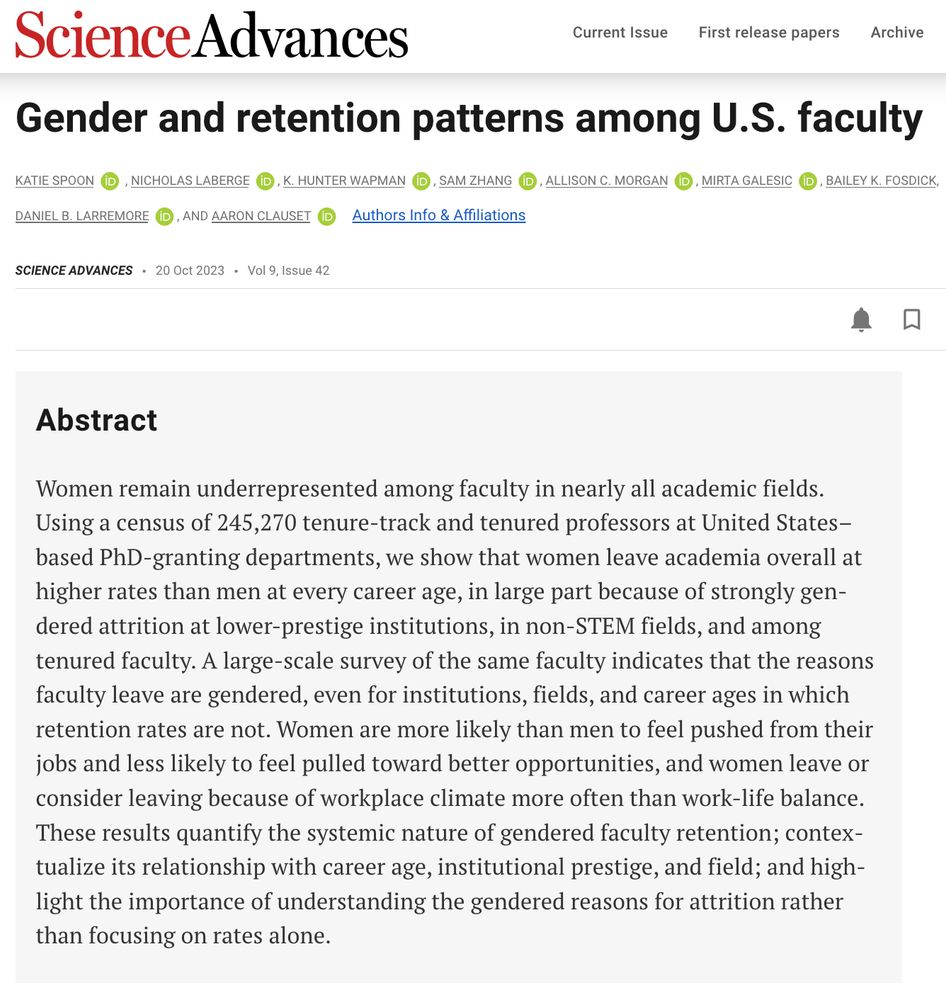Computational Social Science
he/him
- Hiring has had a greater impact on women's representation (2011-2020)
- Hiring is projected to be more impactful for future parity
- Yet women are more likely to leave faculty jobs at every career stage, limiting trends to parity
Read the article for all of the details!

- Hiring has had a greater impact on women's representation (2011-2020)
- Hiring is projected to be more impactful for future parity
- Yet women are more likely to leave faculty jobs at every career stage, limiting trends to parity
Read the article for all of the details!
A systematic study of gendered rates & reasons for faculty attrition in US academia 🧵

🚀 Substantial changes to hiring are needed to boost repr. in most fields
👴🏻 Waiting for retirement-driven turnover won't fix gender disparity
🏁 Many fields won’t reach parity if gendered differences in attrition persist

🚀 Substantial changes to hiring are needed to boost repr. in most fields
👴🏻 Waiting for retirement-driven turnover won't fix gender disparity
🏁 Many fields won’t reach parity if gendered differences in attrition persist
Here's an example of projections for the Natural Sciences from 2020 onward for 5 scenarios:

Here's an example of projections for the Natural Sciences from 2020 onward for 5 scenarios:
- when the older generations of faculty retire?
- if gendered differences in attrition are eliminated?
- or if more women are hired as faculty?
- when the older generations of faculty retire?
- if gendered differences in attrition are eliminated?
- or if more women are hired as faculty?
We show that pre-retirement attrition is gendered–women are more likely to leave faculty jobs than men at every career stage.
Yet all-cause attrition increases women's representation due to retirements.
We show that pre-retirement attrition is gendered–women are more likely to leave faculty jobs than men at every career stage.
Yet all-cause attrition increases women's representation due to retirements.
🔍 Hiring increased women’s representation in 95% of fields
🔍 Attrition (including retirements) increased women’s repr. in 74% of fields
🚀Hiring was the main driver in 87% of fields.

🔍 Hiring increased women’s representation in 95% of fields
🔍 Attrition (including retirements) increased women’s repr. in 74% of fields
🚀Hiring was the main driver in 87% of fields.
The answer matters—interventions differ!—yet can't be learned from representation stats alone.
Here, we use high-res data to separate & quantify the 2 effects over 10 yrs.
The answer matters—interventions differ!—yet can't be learned from representation stats alone.
Here, we use high-res data to separate & quantify the 2 effects over 10 yrs.
🎓 have received more than 50% of BAs since 1981 and
👩🎓 earned 46% of U.S. PhDs in 2021 (🔬38% in STEM, 📚59% in non-STEM)
👩🏫 women comprise _only 36%_ of tenure-track faculty
🎓 have received more than 50% of BAs since 1981 and
👩🎓 earned 46% of U.S. PhDs in 2021 (🔬38% in STEM, 📚59% in non-STEM)
👩🏫 women comprise _only 36%_ of tenure-track faculty

